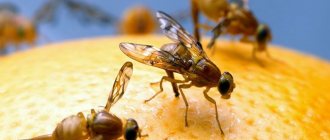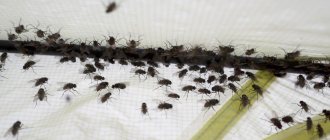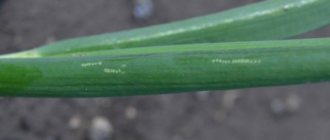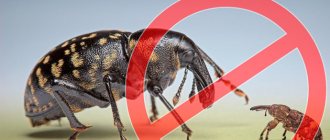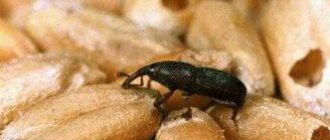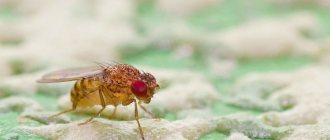Greetings, dear ones! Summer is coming, which means the amount of fruits and vegetables at home will increase significantly! If stored incorrectly or for a long time, some fruits and vegetables begin to rot, we don’t have time to keep track of this and, as an option, nasty black midges appear.
Getting rid of them is not so easy. But I have prepared this article for you, from which you will learn how to get rid of midges in an apartment. Read!
Who among us has not encountered this problem? Midges appear suddenly in an apartment and are very annoying, annoying the residents with their presence. Some species - and there are a lot of them - can even bite. But the good news is that the methods of dealing with them are the same, and you don’t have to read a bunch of literature in order to determine which of their representatives you are fighting with.
Where do small midges come from in an apartment?
The very first thing to do is to establish the cause of the appearance of midges. Only after this can you begin to effectively fight them in the apartment.
Where they can come from is a mystery to many, because outside the window it can be any time of the year. The windows and doors are closed in winter, that is, there is simply nowhere for midges to fly in.
We list the main reasons for the appearance of these unwanted guests in your home:
Biologists say one of the most common reasons for the appearance of midges in an apartment is dirty fruits or vegetables brought home from the garden or store.
Long before they appear on your table, eggs were laid on the fruits, which are in a state of rest, remission, waiting for the fruit to begin to deteriorate and rot.
This is where their finest hour comes, because this is the main food for midges. Larvae emerge from the eggs, which very quickly turn into midges.
Their lifespan is very short, only about a day. But in the presence of an abundant nutrient medium, for example, rotting fruit, they multiply very intensively, which leads to the rapid filling of the room with these insects if measures to eliminate the outbreak were not taken in time.
A very common and widespread reason for the appearance of midges is also insufficient hygiene of the trash can and irregular garbage disposal.
There may be eggs in the leftover food lying in the garbage, and when rotting begins, they begin to wake up.
If the waste gets on the surface of the bucket itself, and is not noticed, this can also serve as the arrival of an army of small parasites.
You should also remember about such a place in the house as a living corner
There is always organic matter with traces of rotting there. For example, an aquarium with abundant algae growth and water that has not been changed for a long time, or a cage with a rabbit or other animal. Such places should always be clean so that insects do not have the opportunity to feed there and lay eggs.
Indoor plants can also cause abundant reproduction of midges
Especially if such a folk method of fertilization as tea leaves is used. Midges are very fond of tea and its remains.
Also, the cause may be high humidity in and around the pots, associated with abundant watering of indoor plants.
Well, the most mysterious place where midges appear, when it seems that everything around is simply licked and perfectly clean, is the water supply and sewage system
Pieces of food falling into the sewer can get stuck in the siphons of sinks and toilets and continue to rot there. This provokes the constant and uncontrollable appearance of midges throughout the house.
From all of the above, we can conclude that midges appear in the house precisely because of problems with the hygiene of the room and its communications.
Midges enter the house only with the help of a person who personally brings them into the house. Their further life and development depends on the cleanliness of the room in which they find themselves.
Danger of bites
Midge bites affect areas of the skin not covered by clothing: face, neck, arms, legs. Usually bloodsuckers attack en masse and only during the daytime. They are especially active in the summer. At the same time, the optimal temperature conditions for “eating” are from 17 to 20 °C. The midge circles over its victim for a long time, then crawls over the body in search of a place with thin skin suitable for a bite, since the bloodsucker has too short a proboscis, which the thick epidermis simply cannot bite through. Because of this careful targeting, midges often end up in the ears, eyes and nose. It has been noticed that most often midges bite human legs. However, a clear explanation for this preference has not yet been found.
Decorated, tundra, and red-headed midges are dangerous because they are carriers of onchocerciasis (damage to the skin, eyes and lymph nodes by helminths).
This is interesting. As a result of many years of research, scientists have come to the conclusion that every 15 midges are infected with onchocerciasis in livestock.
All blood-sucking species of midges can provoke simulidotoxicosis, an allergic disease that is manifested by itching, the development of edema and the appearance of papules. These symptoms may be accompanied by tachycardia and hyperemia, that is, overcrowding of blood vessels. In addition, midges carry infectious diseases that affect poultry and pigeons. In hot latitudes, flying bloodsuckers can infect such deadly infections as:
- leprosy;
- anthrax;
- plague;
- glanders.
Midges bite all exposed skin
Midges are dangerous because their bites can cause allergic reactions (especially in children). This is due to the fact that insect saliva gets onto the damaged area.
It is very important not to scratch the bite site (otherwise you can get infected), but to neutralize the effect of the toxic substance with alcohol. If the mucous membrane is affected, then you cannot do without the help of a specialist. In this case it is prohibited:
- apply medications to the bite site without the approval of a doctor;
- treat the damaged area with household chemicals;
- apply any ointments to the wound, as they will provoke a strong burning sensation.
Itching and swelling are considered the first signs of an allergic reaction to midge bites.
This is interesting. Midges, despite their modest size, bite even more painfully than mosquitoes.
Prevention rules - how to prevent midges from appearing in your apartment in the future?
Preventing the appearance of midges in your home is very simple and clear. This -
Compliance with hygiene rules for residential premises
- Regular cleaning and trash removal.
- Regular cleaning of the trash can.
- Siphon cleaning.
- Timely discarding of food that has begun to spoil.
Also, pungent and persistent odors are good for preventing midges. For example, the smell of garlic or geranium, camphor or incense, if they do not prevent the appearance of midges 100%, will significantly reduce the risk of their appearance.
These measures are guaranteed to rid your home of annoying, uninvited guests.
Source: colady.ru
Reasons for the appearance of midges in the apartment
Where do the midges come from in my apartment? - a question that worries many housewives. To answer it, we will analyze in detail what these flies are, how they reproduce and what they like.
Fruit flies are different - fruit flies do not live long, but it all depends on the living conditions. The cooler the environment, the longer the flies live. Therefore, in winter they live up to three months, and in summer, when the air temperature rises to 25 degrees, they live only 10 days.
Drosophila reproduce very quickly. At one time, flies lay up to 80 eggs.
They prefer fruits and vegetables, sweet juices, syrups and alcohol. Once in the nutrient medium, larvae emerge from their eggs - white worms 3 millimeters long. In a favorable environment, midges appear within 4 days, and after eight hours they are already laying eggs. Therefore, there are always a lot of them in the house, unless measures are taken to destroy them.
There are several features of these insects: Drosophila lay eggs under the skin of ripe fruits, so no matter how much the fruits are washed, the larvae are there.
To get rid of them you need to wash them with soap or pour boiling water over the fruits. They also feel good in sewers, which is why they are confused with sewer flies. Midges appear early in the morning, so it seems to a person that they come out of nowhere.
Drosophila can feed and reproduce on 400 different types of plants. It’s hard to even imagine how much this is. Flies prefer sweet and citrus smells and can even be attracted to the smell of air freshener.
If a fruit fly is deprived of food and habitat, it may fly away. But how long it can fly on its tiny wings remains a mystery. Fruit midges react well to sudden movements and fly away, so if you decide to catch them manually, be patient.
Because no matter how much you catch it, it will still fly away. It will be more effective to use traps. A dry environment is destructive for midges. She loves dampness and mold, and tolerates frost quite well.
Do dichlorvos and fumigator help?
Dichlorvos is a very effective remedy for midges, but the owners don’t like it either. The leaves of plants can be burned with dichlorvos, so it is better to spray them into the ground. As a last resort to kill the larvae, this drug is suitable.
If possible, it would be better to poison insects in other ways.
As for fumigators, their effectiveness depends on the composition that serves as a source of an aroma unpleasant to insects. It is necessary to connect the device to an electrical network, otherwise the smell will not be released because the special plate soaked in the odorous solution or the liquid in the bottle screwed to the fumigator does not heat up.
The product is highly effective in combating not only midges, but also mosquitoes, flies and other insects.
Causes of midges
Where do midges come from in an apartment? There are quite a few reasons for their appearance. The main ones are described below: Midges appear in the house if you do not sort out fruits and vegetables in time; rotten fruits are a good environment for their habitat and reproduction.
Dishcloths, floor rags and towels need to be washed frequently because dirt and moisture favor their proliferation. Sinks at home should be cleaned of food debris after each dishwashing, as decaying organic matter contributes to their appearance.
Leaking pipes are a favorable environment for fruit flies, as they love dampness and mold. Therefore, even a small leak can provoke the appearance of a whole horde of nasty midges. Bottles of wine and various syrups should be kept tightly closed, because fruit flies love sweets.
The reason for their appearance may be that the trash can is not taken out. The result will be a horde of annoying midges in your home. Many people wonder why they appear, despite the cleanliness of the apartment. No matter how much you clean, they can fly in from the street or through the ventilation.
Therefore, it is necessary to take care of mosquito nets on windows and ventilation ceilings. Midges can appear not only in the kitchen, but also in the bathroom or toilet. A wet rug or poorly washed bath will suffice.
Pots with indoor flowers are also a favorable habitat for annoying midges if there is constant humidity there. To avoid their appearance, you should cover the ground around the plant with decorative stones or granite chips.
Source: hozuyut.ru
How to get rid of small midges in an apartment
Unfortunately, even the most meticulous housewives can become victims of hordes of annoying midges.
It is important to understand that these creatures are not as harmless as you might initially think: such proximity can even lead to allergies.
If you discover that midges have appeared in your apartment, you shouldn’t delay eliminating them: that’s why you need to figure out how to deal with them in advance.
Reasons for appearance
First, it is imperative to find out the reason for the appearance of midges in your home. So, where do midges come from in an apartment?
In fact, there can be quite a few reasons for the appearance of these unwanted guests, especially in the warm season: spoiled vegetables and fruits, garbage not thrown out in a timely manner, food debris accumulated in drainpipes, dirty feeders or animal toilets, stagnant water in the aquarium or in flowers.
If you are confident in the impeccability of your cleaning, do not exclude the possibility of a “raid” of midges from your neighbors. So, let’s draw conclusions and get started on how to get rid of small midges in an apartment.
How to fight
The good news is that midges can be defeated using simple mechanical methods and folk tricks. You don’t need to spray toxic insecticides around the house and you don’t have to remember about the well-deserved insect fighter - dichlorvos: The easiest and most accessible way to fight insects, no matter how funny it may sound, is a vacuum cleaner.
Carefully walk with it through places where pests accumulate and, having mercilessly sucked them in with the device, empty the dust collector away from the house.
If small midges in your apartment have infested indoor plants, you need to insert several matches into the pot with the sulfur head down, and also stop fertilizing the flowers with tea.
It is also recommended to spray the plant with a weak solution of potassium permanganate. Making midge traps is an effective control method. For example, you can make a funnel from a plastic bottle or use a yogurt cup, at the bottom of which put a piece of spoiled fruit, a drop of jam or honey.
After collecting the “catch”, dispose of the vessel. An alternative to sweet bait can be a small amount of alcohol. You can use ready-made traps - sticky tapes, placing them closer to the places where midges swarm.
If the place where midges appear is your bathroom, then the best and easiest way is to pour jam syrup into the bathtub. As soon as the midges flock to the sweets, quickly wash them off with a hot shower. Then don’t forget to clean the bathtub, wipe the floor dry and pour boiling water over all the drain holes.
Prevention
To avoid stepping on a rake again, it is recommended to follow a number of preventive measures. First, place mosquito nets on the windows, thereby limiting the possibility of midges entering from the street.
Secondly, do not forget to throw out garbage in a timely manner and sort through fruits/vegetables, sift cereals and flour. You can protect yourself from these parasites in the kitchen by placing walnut leaves or lavender-scented tablets in your cabinets.
Thirdly, wash the aquarium and animal food plates more often. Don’t forget to change the litter in your little brothers’ toilets on time and keep their bedding clean.
Fourthly, do wet cleaning in the apartment more often. This is especially true for hard-to-reach places: under the refrigerator, behind the stove, between tables.
Fifthly, make sure your plumbing is in good working order to avoid unwanted moisture stagnation.
Source: beyklopov.ru
Fighting onion midge: best methods
Midges are small flying insects with two wings that happily settle in human homes and feed on plant foods.
In fact, the onion midge consumes not only onions, but also settles on other fruits, berries, and vegetables that are not stored properly in the apartment. There are several species of midges that live on plant products, and most often these are Drosophila (fruit flies) and soil flies.
You should not think that, apart from aesthetic harm, such small insects do not interfere with humans in any way. Even small midges are carriers of diseases. In people prone to allergies, their bites can cause severe skin reactions and swelling.
These insects lay their eggs on food, the larvae emerge from them and immediately begin to feed intensively. Midges stain furniture, walls, and can even fly into a person’s mouth and nose.
Here are the main signs of midges that most often settle at home:
- Size – 1-3 mm
- Oval body
- Slow flight, not like a regular fly
- Six legs, two wings
- Yellowish, brown, black body color
ATTENTION: Whatever species the onion midge belongs to, in a very short period of time its colony will become numerous, because these pests reproduce extremely quickly.
Where do midges come from?
Despite their small size, insects can fly considerable distances, so they can end up in any apartment. They get to new housing in different ways, here are the main ones:
- Insect eggs may be present on vegetable and fruit products that were bought in a store, at the market, brought from a dacha, or taken from friends.
- It is possible that one or a couple of individuals accidentally enter through a window or door, after which they lay eggs and “start” the reproduction process.
- Pests also enter through ventilation from neighbors.
- To reproduce, insects need a nutrient medium - warm, rotting foods, spilled juices, pieces of plant food lying around, used tea bags, sewerage with an abundance of plaque. Female small flies can also lay eggs on the bedding and food of pets, for example, when their cages are rarely cleaned. Midges love wet, unwashed kitchen rags and napkins.
Midges from onions breed especially well, because if stored improperly, this vegetable begins to rot quickly. Many housewives have onions in a dark, warm place, wrapped in a plastic bag, and this is an ideal condition for them to rot.
Therefore, midges on onions multiply at tremendous speed, and will soon fly throughout the kitchen in dozens and hundreds.
Signs of infection
Midges are too small to immediately detect their presence. They hide under leaves and in moist soil. Only when they reach a huge number do they reveal themselves. In most cases, the larvae are found in the ground, in the area of the root system, so it is quite difficult to see them. Despite the “secrecy”, there are some signs that allow you to accurately determine the presence of parasites. These include:
- the occurrence of diseases;
- the appearance of a whitish coating on the leaves and stems;
- the substrate or soil becomes crumbly;
- the ground “fades” a little.
The most vulnerable species are considered to be:
- fuchsia;
- azalea;
- ficus;
- aloe;
- epiphytic cacti;
- gerberas;
- violets;
- begonias.
What to do if you find onion midges?
How to get rid of onion midges is a paramount question, and you need to start solving it by finding a place for their active reproduction. The main thing is to leave pests without food and a breeding ground for their offspring. The procedure will be as follows:
- Throw away spoiled onions, carefully sorting through all available vegetables.
- Place the onions in the refrigerator without signs of rotting or spoilage, placing them in small portions in plastic bags.
- If it is not possible to put onions and other root vegetables in the cold, they should be stored in boxes with sawdust, or, as a last resort, in well-ventilated fabric bags.
- Remove all fruits, especially citrus fruits, out of reach of midges.
- Throw out garbage on time, at first - 1-2 times a day.
- Wash dirty dishes immediately after eating.
- Limit the access of insects to water - they also need it for life. To do this, you should close all taps so that they do not drip, leave sinks dry, do not store water on the table, and thoroughly dry clean dishes.
- Remove and clean siphons a couple of times a week and use disinfectants to clean the sewer system.
- Wash your pets' cages regularly and prevent food residues from being left there.
IMPORTANT: If there are plants in the apartment, they also need to be cleaned, because insects can settle on them for lack of other food. You should reduce the frequency of watering and stop pouring tea leaves on the ground. If necessary, you can spray the flowers with a weak solution of potassium permanganate.
How to make midge traps?
Onion midges sometimes multiply on such a scale that simply getting rid of rotting vegetables does not bring proper and quick results. In this case, the hostess will have to take a number of more radical measures to get rid of uninvited guests. How to make baits with your own hands where insects will die? Here are good ways:
- Take a 0.5 liter plastic disposable glass, throw a piece of fruit into the bottom or pour a little sweet juice (compote). Wrap the glass in cling film, making several small holes in it. Leave the trap in the kitchen overnight, quickly put the glass in a tight bag in the morning and take it out of the house.
- Pour juice into the bottom of the jar or put overripe fruit, cut into slices. Cover the top of the jar with a paper funnel, placing its narrow side inward. Leave the jar on the table at night, pour water into it in the morning - all the midges will die.
- Pour water into a flat plate, drop a little citrus-scented dishwashing detergent into the water. The insects will land on the water, but will no longer be able to take off.
You can also get rid of flies using medications. Nowadays, any store sells special adhesive tapes and sheets to which harmful insects quickly stick. It is not recommended to use aerosols and other chemicals, because their residues can end up on the table or in food, causing harm to humans.
But ventilating the apartment and mechanically removing pests using a towel through the window, or sucking them up with a vacuum cleaner will definitely not do any harm and are perfect as one of a set of measures to combat midges.
Reviews
A homemade apple cider vinegar trap works well. Quickly and without much effort I got rid of all the flies.
I buy the Aeroxon trap all the time. The result is excellent. You never see flies in the kitchen. They are great for bait.
I recommend Combat Multi Spray aerosol to everyone. I have never come across a better remedy.
Who among us has not encountered this problem? Midges appear suddenly in an apartment and are very annoying, annoying the residents with their presence. Some species - and there are a lot of them - can even bite. But the good news is that the methods of dealing with them are the same, and you don’t have to read a bunch of literature in order to determine which of their representatives you are fighting with.
The content of the article:
How to prevent the reappearance of pests?
To prevent insects from settling in your house or apartment again, you need to take measures to repel them. Thus, onion midges cannot tolerate the smell of pine needles and basil. Therefore, you need to purchase essential oils of fir, pine, and basil, soak cotton wool in them and place them in places where vegetables are stored.
Insects do not like the smell of clove seasoning - it can be stuck into citrus fruits that are stored outside the refrigerator. Midges also react negatively to the aromas of ylang-ylang, patchouli, and verbena oils, so they can be dripped into aroma lamps and used regularly.
Midges also cannot stand the smell of camphor, which, by the way, is absolutely not harmful to humans. Preventing the appearance of midges is not difficult, but it is effective, and an unpleasant neighborhood will most likely not happen to them.
Source: gdeklop.ru
Pets
Pets themselves do not cause midges. However, their habitats may be the cause. Therefore, you need to replace sand or other filler in time. In this place, putrefactive processes can begin, resulting in the formation of midges.
Pet feeding containers should be washed immediately. The remaining food begins to rot, causing midges to appear.
